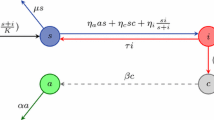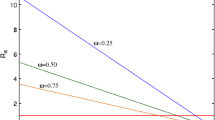Abstract
Anthrax is an acute infectious disease caused by the spore-forming bacterium Bacillus anthracis. It occurs most frequently as a disease of herbivores (e.g., cattle, goats and sheep) that acquire spores from direct contact with contaminated soil. In this paper, we formulate a new mathematical modeling framework to explore the spread of anthrax in the community. Our models include essential components such as fast and slow progression, carcass disposal and vector population. The existence of the disease-free equilibrium is discussed, the basic reproduction number is calculated, and the effect of carcass disposal on the basic reproduction number is studied. Our results suggest that carcass disposal may significantly reduce the spread of anthrax. Carcass disposal targeted at 85 % or more can be effective at stopping the spread of anthrax in the community.



Similar content being viewed by others
References
Baldacchino F et al (2013) Transmission of pathogens by Stomoxys flies (Diptera, Muscidae): a review. Parasite 20:26
Castillo-Chavez C, Song B (2004) Dynamical models of tuberculosis and their applications. Math Biosci Eng 1(2):361–404
Castillo-Chavez C, Feng Z, Huang W (2002) On the computation of \({\cal R}_0\) and its role on global stability. In: Castillo-Chavez C et al (eds) Mathematical approaches for emerging and re-emerging infectious diseases: an introduction, vol 125. IMA, pp 229–250
CDC (2010) Morbidity and mortality weekly report. Use of anthrax vaccine in the United States recommendations of the advisory committee on immunization practices (ACIP), 2009. www.cdc.gov/mmwr. 59(6)
Chitnis N, Hyman JM, Manore CA (2013) Modelling vertical transmission in vector-borne diseases with applications to Rift Valley fever. J Biol Dyn 7(1):11–40
Davies JC (1983) A major epidemic of anthrax in Zimbabwe. 2. Distribution of cutaneous lesions. Cent Afr J Med 29:8–12
Friedman A, Yakubu AA (2013) Anthrax epizootic and migration: persistence or extinction. Math. Biosci. 241:137–144
Hahn BD, Furniss PR (1981) A mathematical model of anthrax epizootic in the Kruger National Park. Appl Math Model 5:130
Hahn BD, Furniss PR (1983) A deterministic model of anthrax epizootic: threshold results. Ecol Model 20:233
Lahodny GE Jr, Gautam R, Ivanek R (2014) Estimating the probability of an extinction or major outbreak for an environmentally transmitted infectious disease. J Biol Dyn. doi:10.1080/17513758.2014.954763
LaSalle JS (1976) The stability of dynamical systems. CBMS–NSF regional conference series in applied mathematics, vol 25. SIAM, Philadelphia
Lewerin SS, Elvaander M, Westermark T et al (2010) Anthrax outbreak in Swedish beef cattle herd-1st case in 27 years: case report. Acta Vet Scand 52:7
Marino S, Hogue IB, Ray CJ, Kirschner DE (2008) A methodogy for performing global uncertainty and sensitivity analysis in systems biology. J Theor Biol 254:178–196
Mushayabasa S (2015) Global stability of an anthrax model with environmental decontamination and time delay. Discrete Dynamics in Nature and Society, Article ID 573146
Mushayabasa S, Bhunu CP, Dhlamini M (2011) Impact of vaccination and culling on controlling foot and mouth disease: a mathematical modelling approach. World J Vaccines 1:156–161
Schlingman AS et al (1956) Immunizing activity of alum-precipitated protective antigen of Bacillus anthracis in cattle, sheep and swine. Am J Vet Res 17:256–261
Survely AN, Kvasnicka B, Torell R (2001) Anthrax: a guide for livestock producers. Cattle producer’s Library CL613. Western Beef Resource Committee
Van den Driessche P, Watmough J (2002) Reproduction numbers and sub-threshold endemic equilibria for compartmental models of disease transmission. Math Biosci 180:29–48
World Health Organization (2008) Anthrax in humans and animals, 4th edn. World Health Organization, p 29
Acknowledgments
The authors would like to thank the two anonymous reviewers and the editor for their suggestions that improved this paper.
Author information
Authors and Affiliations
Corresponding author
Ethics declarations
Conflict of interest
None.
Additional information
Communicated by Florence Hubert.
Rights and permissions
About this article
Cite this article
Mushayabasa, S., Marijani, T. & Masocha, M. Dynamical analysis and control strategies in modeling anthrax. Comp. Appl. Math. 36, 1333–1348 (2017). https://doi.org/10.1007/s40314-015-0297-1
Received:
Revised:
Accepted:
Published:
Issue Date:
DOI: https://doi.org/10.1007/s40314-015-0297-1




